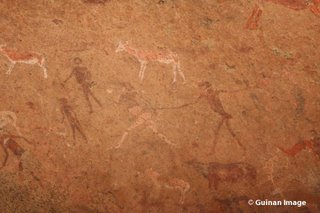Waking at Vingerklip, our big picture window revealed a beautiful dawn in a clear blue sky. To the restaurant for breakfast (very Germanic), and really wonderful views. Alas, we musn't linger - we have a date with the White Lady, who waits for us at the foot of Namibia's highest mountain some hours to the south. First, we drove west to refuel at Khorixas, having been warned that Uis doesn't always have petrol. About 30km outside town, we stopped for hitchhikers: a young woman and a little girl who might have been her daughter, together with their luggage - a net bag full of a green fruit I didn't recognise. At the edge of Khorixas, they got off outside the hospital.
The petrol station was something of a revelation; poverty exposed in way we hadn't seen before. Lots and lots of people squatting or slouching in the shade, most with no apparent connection to an actual vehicle. Poor clothes - patches and holes - and one quite young man who had lost the vision of his right eye to a cataract. We immediately attracted the attention of several men carrying scalpels and nuts on strings: these men scrape a living of sorts by cutting scenes of wildlife on the side of these nuts, and adding the names of tourists to make a personalised souvenir. Competition was fierce - as soon as the secret of our names was out, several heads were bent in concentration as they carved; we had had absolutely no intention of buying any such thing, but ended up purchasing from 3 men nuts with the names of various friends and family, swayed by a combination of their pitiful clothes, their desperation, and the memory of the Red Cross aid station we'ld passed a block or so back. Glad to leave town: we'ld felt a little besieged.
Moving south, we found an increasingly parched landscape; the large farms of the east now replaced by modest little holdings, the imposing gates and long drives exchanged for ramshackle farmhouses within sight of the road. A parallel traffic system is operation, with the (very occasional) pickup truck using the main highway (a gravel road of generally good quality) and donkey carts using tracks on either side of the main road. Beautiful scenery, dominated by the Brandberg Massif, but a very tough climate - we crossed only a single bridge in a whole day's driving - hundreds of kilometres. There are plenty of rivers on the map, but these are, almost without exception, bone dry. We did encounter some wet sumps (bring a 4x4) but the road is mostly very good. Very little traffic; despite this, the roadside in the vicinity of the Ugab river is full of souvenir stalls operated by ladies in spectacular traditional dress.
Arriving at the White Lady turn-off, we were stopped in our tracks by four or five skinny little children who wanted in the first instance to get water, and in the second to trade food for rock crystals. We filled their bottle, and promised to return later - which we did, swapping biltong for an embarrasingly generous amount of rock crystal. Big heartbreaking smiles from the shoeless, shirtless children.
Reaching the car park at the foot of the mountain, we paid our entrance fee - for which we received the services of a guide. Covered in insect repellent and sun screen, we began the 45 minute hike to the paintings only after swilling enormous quantities of water - the heat of the afternoon in that windless ravine was, if not furnace-like, at least oven-like. Our guide turned out to be excellent - as well as living near by, he had studied the geology, flora, fauna, and history of the mountain, and was able to enlighten us on subjects ranging from basaltic outcroppings to life cycle of the enormous tadpoles swimming in the river that flows along the floor of the ravine. The walk is quite easy (apart from the heat), but does require fording the river eight or so times - flip flops would be a better choice than hiking boots. Reaching the White Lady herself, we appreciated the shade of the boulders very nearly as much as the cultural and historic aspects. Incidentally, the "White Lady" is actually a man - probably what we would call a "Witch Doctor". Painted by the San (also known as Bushmen) , the paintings are a relic of a culture since vanished from the area. Ever wondered why they live in the harshness of the Kalahari? Because other drives drove them out of everywhere else (other tribes forced them from this area four or five centuries ago).
Thursday, May 25, 2006
Subscribe to:
Post Comments (Atom)


No comments:
Post a Comment